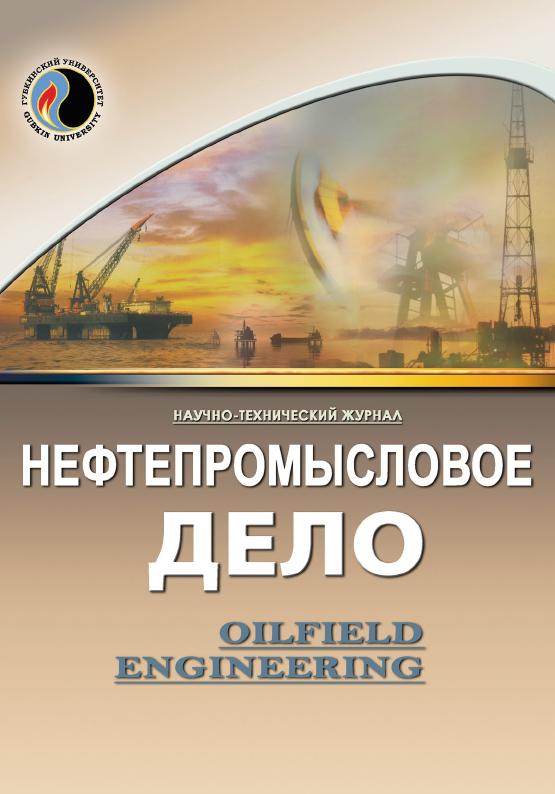Scientific and technical journal
«Oilfield engineering»
ISSN 0207-2351

Experimental studies to justify the use of demulsifiers when conducting acid hydraulic fracturing
UDC: 622.276.66.002.34
DOI: 10.33285/0207-2351-2023-6(654)-43-49
Authors:
1 Almetyevsk State Oil Institute, Almetyevsk, Russia
Keywords: acid hydraulic fracturing, oil-acid emulsion, interfacial films strength, interfacial tension, demulsifier
Annotation:
One of the most demanded technologies aimed at increasing or restoring the productivity of producing wells in carbonate reservoirs is acid treatment. The efficiency of acid treatments does not exceed 50…60 %, both in new and old fields, which is caused by a number of factors, including the formation of high-viscous oil-acid emulsions and sludges. The demulsifier adsorption kinetics at the interface of crude oil and water can be used as a method that characterizes an emulsion or the effect of a demulsifier on its properties. Taking into account the fact that the demulsifier adsorption process affects the strength of interfacial films formed on the oil–water interface, the assessment of this parameter and its changes will allow predicting the stability of the emulsion with a fairly high accuracy. In order to study the heterogeneity of the strength of interfacial films and determine the effect of various types of demulsifiers on it, experimental laboratory studies were carried out. The object of the study was oil-acid emulsions prepared from wellhead oil samples from the wells of the Vishnevo-Polyansky, Aksubayevo-Mokshinsky, Yamashinsky fields and 15 % hydrochloric acid, as well as demulsifier reagents. An aqueous solution of a mixture of anionic, nonionic surfactants and ethylene glycol and a mixture of block copolymers of ethylene and propylene oxides in an organic solvent were used as demulsifiers. It is noted that the effect of the concentration influence on the decrease of the films strength depends both on the type of demulsifier and on the specific well and field object. The greatest decrease of the strength of oil-acid emulsions interfacial films in case of the concentration increase is observed for the demulsifier, which is a mixture of block copolymers of ethylene and propylene oxides in an organic solvent. It is caused by the good solubility of this demulsifier in oil, which affects the diffusion of components to the interface, more efficient displacement of natural stabilizers from the interface, and a significant decrease of the interface film strength.
Bibliography:
1. Podbor effektivnogo kislotnogo sostava dlya obrabotki karbonatnogo kollektora / E.E. Akhmerova, E.A. Shafikova, G.I. Apkarimova [i dr.] // Bashkirskiy khimicheskiy zhurnal. – 2018. – № 3. – S. 86–92.
2. Magadova L.A., Silin M.A., Davletshina L.F. Kolloidno-khimicheskie issledovaniya pri razrabotke kislotnykh sostavov // Neftegaz.RU. – 2022. – № 7.
3. Formation, stabilization and chemical demulsification of crude oil-in water emulsions: A review, Petroleum Research / E. Yonguep, K.F. Kapiamba, K.J. Kabamba [et al.]. – URL: https://doi.org/10.1016/j.ptlrs.2022.01.00
4. Glushchenko V.N., Silin M.A. Neftepromyslovaya khimiya. V 5 t. – T. 4. Kislotnaya obrabotka skvazhin / pod red. prof. I.T. Mishchenko. – M.: Interkontakt Nauka, 2010. – 703 s.
5. Surguchev M.L., Simkin E.M. Faktory, vliyayushchie na sostoyanie ostatochnoy nefti v zavodnennykh plastakh // Neft. khoz-vo. – 1988. – № 9. – S. 31–36.
6. Sorokin A.V., Sorokin V.D. Issledovanie protsessa izmenchivosti fiziko-khimicheskikh svoystv plastovoy nefti pri razrabotke mestorozhdeniy Zapadnoy Sibiri. – Tyumen’: Vektor-Buk, 2004. – 237 s.
7. Sheykh-Ali D.M., Yulbarisov E.M. Izmenenie svoystv nefti i gazovogo faktora pri razrabotke neftyanykh mestorozhdeniy // Interval. – 2003. – № 1(48). – S. 30–35.
8. Ibatullin R.R. Osnovnye napravleniya deyatel’nosti i vklad TatNIPIneft’ v razvitie neftyanoy promyshlennosti // Sb. dokl. nauch.-tekhn. konf., posvyashch. 50-letiyu Tatarskogo nauchno-issledovatel’skogo i proektnogo instituta nefti. – Bugul’ma, 2006.
9. Muslimov R.Kh. Sovremennye metody povysheniya nefteizvlecheniya: proektirovanie, optimizatsiya i otsenka effektivnosti: ucheb. posobie. – Kazan’: FEN, 2005. – 688 s.
10. Petrova L.M., Romanov G.V., Foss T.R. Izmenenie sostava nefti v protsesse dobychi // Neft. khoz-vo. – 2004. – № 7. – S. 62–64.
11. Shirazi M.M., Ayatollahi Sh., Ghotbi C. Damage evaluation of acid-oil emulsion and asphaltic sludge formation caused by acidizing of asphaltenic oil reservoir. – URL: https://doi.org/10.1016/j.petrol.2018.11.051
12. Kosmacheva T.F., Gubaydullin F.R., Ismagilov I.Kh. Novye podkhody k otsenke effektivnosti deemul’gatorov // Novye metody dobychi, podgotovki i transportirovki nefti: sb. dokl. nauch.-tekhn. konf. – Oktyabr’skiy, 2004. – S. 56–64.
13. Diyarov I.N., Bashkirtseva N.Yu., Kuryashov D.A. Kislotnyy sostav dlya napravlennoy obrabotki prizaboynoy zony plasta // Materialy IV Vseros. nauch.-prakt. konf. "Neftepromyslovaya khimiya". – M., 2008. – S. 92.
14. Osobennosti formirovaniya i razrusheniya vodoneftyanykh emul’siy na pozdney stadii razrabotki neftyanykh mestorozhdeniy / R.Z. Sakhabutdinov, F.R. Gubaydullin, I.Kh. Ismagilov, T.F. Kosmacheva. – M.: OAO "VNIIOENG", 2005. – 134 s.
15. Neftegazonosnost’ Respubliki Tatarstan. Geologiya i razrabotka neftyanykh mestorozhdeniy / pod red. prof. R.Kh. Muslimova. – V 2-kh t. – T. 2. – Kazan’: FEN, 2007. – 524 s.